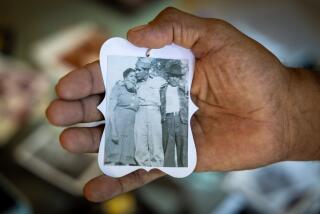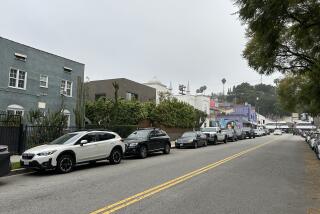Drawing the Line : Planners Meld Activism, Urban Projects
- Share via
Back in 1971, the idea was novel. No one had ever suggested using brick walls to muffle traffic noise along Southern California’s freeway system.
That, however, did not stop five idealistic planners and activists from proposing 15-foot-high walls to protect the Ramona Gardens housing project in Lincoln Heights and a nearby park from noise from the proposed San Bernardino Freeway busway.
The state had contended that the noise would have “no impact to the existing flora and fauna.” Architect Frank Villalobos, one of the five planners, recalled the scientific references and fumed, “And what are we? Tortillas?”
To speed the busway project, state transportation officials approved the sound wall proposal, and the barriers erected near Ramona Gardens became a forerunner of what has now become a common sight on the 562-mile Los Angeles freeway system.
Different Breed
The victory by the five men, who called themselves Barrio Planners Inc., marked their emergence as a different breed of urban planners, bringing political activism to the drafting board to try to improve life in impoverished barrios.
Most architects and planners say that’s unusual in a field where political conviction usually takes a back seat to structural integrity.
While some critics, including one of the founding members, believe that Barrio Planners has not lived up to the idealism that prompted its formation in 1971 as a nonprofit “community design center,” most community activists and planners have nothing but praise for the group.
“They were an inspiration to us who are fighting the prison,” said Lucy Ramos, a founder and president of the 1,000-member Mothers of L.A., which opposes the proposed state prison site in an industrial area southeast of the Los Angeles Civic Center.
Latino History, Pride
Barrio Planners is responsible for a number of landmarks of Latino history and pride--El Parque de Mexico in Lincoln Heights; the arch over a revitalized Whittier Boulevard, East Los Angeles’ major business thoroughfare, and El Paseo de Las Flores in Boyle Heights, which features a Latino Vietnam Veterans monument.
The group has also designed office buildings, grocery markets, playgrounds and even country clubs.
But in keeping with the advocacy course set by the busway fight, the group has taken on the establishment over the years on a number of issues:
- The group and Villalobos, its managing director, are credited by several Eastside politicians with marshaling opposition to the proposed downtown prison site. Villalobos’ lobbying of Senate President Pro Tem David Roberti (D-Los Angeles) and Archbishop Roger M. Mahony of Los Angeles was seen as pivotal in galvanizing opposition to the prison.
- The group has been instrumental in the fight over a controversial hazardous waste incinerator proposed in the city of Vernon. Because of the opposition, the city must prepare an environmental impact report on the incinerator. The same tactic, used by the group 17 years ago, prompted the state to build the sound-abatement walls to protect the Ramona Gardens project.
- The group forced the Los Angeles Community Redevelopment Agency to change its contracting procedures about four years ago to ensure that minority-owned firms could bid on the agency’s public projects.
“I was impressed by the evidence brought forward” to force the change, CRA Chairman Jim Wood said.
- Six months ago, Barrio Planners entered the squabble over the future of Olvera Street by conducting a $100,000 study on how to revitalize the one-time back alley that symbolizes Los Angeles’ Latino beginnings. The study was done at the behest of Olvera Street merchants who are fearful that the proposed development of nearby Union Station and Terminal Annex will engulf them.
Barrio Planners’ willingness to fight for Eastside concerns has earned the grudging respect of many planners, including those who have to pass judgment on their work.
“It’s a well-rounded firm that is willing to take risks for the Chicano-Latino community,” said Edward Avila, chairman of the Los Angeles City Board of Public Works. “It makes no excuses for the work that it produces. And that’s the bottom line for me and others who have to review it--the work product.”
The president of the Los Angeles City Planning Commission, Dan Garcia, said he thinks enough of Barrio Planners’ activism and its work that he pushed for the group’s inclusion on the Central City West plan, which details downtown Los Angeles’ future development west of the Harbor Freeway.
“I’ve evaluated their work and I think their community orientation is a very positive one,” Garcia said.
‘Community Design Center’
Barrio Planners was conceived in the social idealism of the late 1960s. Villalobos and three fellow students at East Los Angeles College--Raul Escobedo, David Angelo and Manuel Orozco--dreamed of a “community design center” that would do something about the blighted inner city.
They were also keenly aware that less than 8% of the nation’s 75,000 architects were Latino.
“We saw that Chicanos were always getting the shaft as far as urban renewal was concerned,” Angelo said. “We wanted to be the architects and planners for Chicano neighborhoods.”
Indeed, the group’s determination to help the Eastside was fueled by the construction in the area of six freeways, the Sybil Brand Institute for Women and the Los Angeles County Sheriff’s Department complex in the 1950s and ‘60s. Eastside activists blame those projects for disrupting many tightly knit Latino neighborhoods.
‘We Had to Move’
“I’ll never forget when we had to move because of the Pomona Freeway” when it was built in the 1960s, recalled Villalobos, 42, a native of the Maravilla barrio. “When my dad bought that house, we thought we were going to live there forever. We lived there only five years.”
Villalobos, Angelo and Escobedo went on to Cal Poly Pomona, to continue their education. Orozco attended USC.
While other architecture students did research work in the suburbs, the four worked at helping the neighborhoods they grew up in.
After graduating from college, the four established Barrio Planners as a nonprofit community design center. Alex Man, an ardent environmentalist who cared deeply about trees, joined the group as its fifth founding member.
Two other Latinos, Javier Mendoza and Gilbert Flores, also helped establish the group, but they soon left because of its nonprofit status.
Group’s ‘Conscience’
Older than the other four, Man became the “conscience” of the group, railing against the removal of trees from neighborhoods and pollutants from freeway traffic. He was arrested in 1972 after he and two others tried to stop the bulldozing of trees on an East Los Angeles street for a street-widening project.
Work was scarce in the early years, and several members of the group took on full-time jobs during the day. At night, they brainstormed about the projects they could do as Barrio Planners. Escobedo worked at the Los Angeles City Planning Department to make ends meet.
Orozco, now 48, was already married with children when Barrio Planners was formed. He was the hustler of the fledging group, following up on tips for work. He played a pivotal role in obtaining the group’s first project--a park next to Ramona Gardens and the San Bernardino Freeway--that eventually led to the busway dispute.
Appointed to Commissions
His idealism and energy later attracted the attention of others and he was appointed to the California Coastal Commission and the Santa Monica Mountains Comprehensive Planning Commission, the predecessor to today’s Santa Monica Mountains Conservancy board.
For Angelo, his early involvement was strengthened by his decision to refuse military service during the Vietnam War. He was classified as a conscientious objector in 1971 after lengthy hearings, and his assigned alternative work surprised and pleased him.
“(Federal authorities) told me, ‘We are going to locate you in East Los Angeles and (have you) continue what you’re doing with Barrio Planners,’ ” Angelo said. “It was the best of both worlds.”
During 1971 and 1972, he worked at night on home improvement projects, including room additions, to earn extra money.
By 1975, Man, Angelo and Orozco went their separate ways. Villalobos and Escobedo stayed on, eventually deciding several years ago to make the group a profit-making company.
Modest Business
These days, Barrio Planners, although not a licensed architectural firm, has managed to attract modest business. Its current projects range from a proposed $3-million tennis and racquet club in Monterey Park and Metro Rail-related work to a Mexican-theme market and community complex in the Barrio Logan area of San Diego.
The group has been criticized by licensed architects who draw the distinction between themselves and planners who are not licensed. Although Barrio Planners refers to itself as an architectural firm, no one on the staff is a licensed architect. Villalobos is a landscape architect.
A large part of the firm’s energies are directed to its political battles, much of it due to Villalobos’ interest. For example, he said, he has gone to Sacramento 48 times at his own expense to lobby against the proposed prison.
Despite that, sharp criticism of the group’s efforts has come from an unlikely source--founding member Man.
‘Better Things to Fight for’
Over the years, Man said, he has concluded that Barrio Planners has failed to live up to its original concept as a nonprofit community design center. It has fought a prison not physically proposed for the Eastside--the site is across the Los Angeles River from Boyle Heights--while it has ignored the pressing need for better medical facilities for Latinos, he argued.
“There are better things to fight for that are of wider concern,” said Man, 66, who is head of the Federation of Organizations for Conserving Urban Space.
He also criticized the group for its refusal to acknowledge the removal of 2,000 trees from Latino neighborhoods or freeway pollution in a visual study and analysis the group conducted of East Los Angeles in 1972. “What they did was unconscionable,” the veteran environmentalist said.
Responding to the criticism, Villalobos began recounting the battles the group has fought, then abruptly stopped. “We put our butts on the line whenever we can,” he said.
More to Read
Sign up for Essential California
The most important California stories and recommendations in your inbox every morning.
You may occasionally receive promotional content from the Los Angeles Times.










